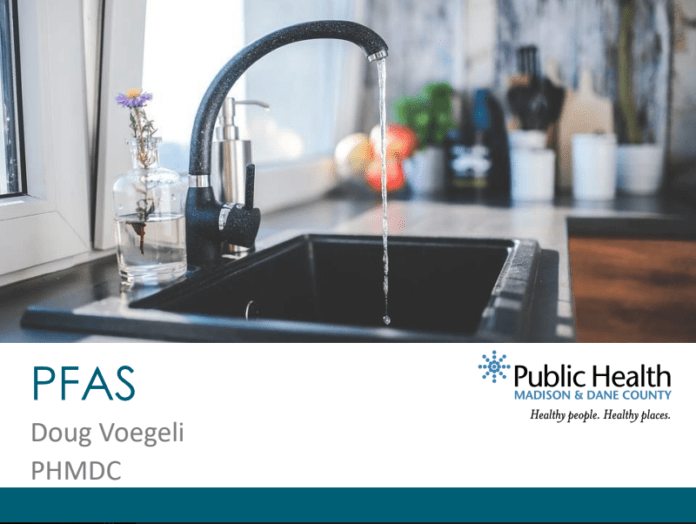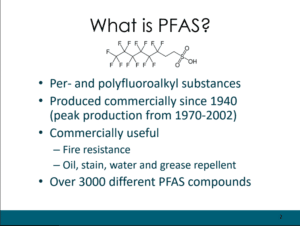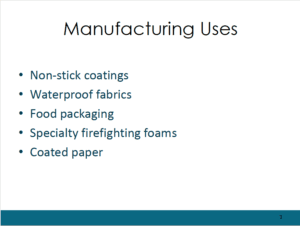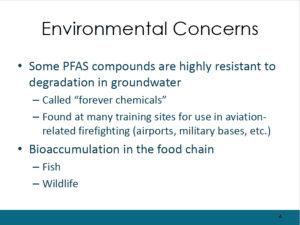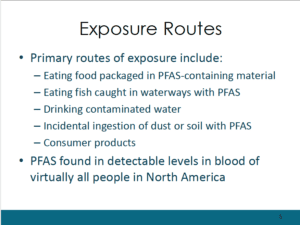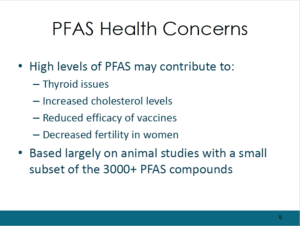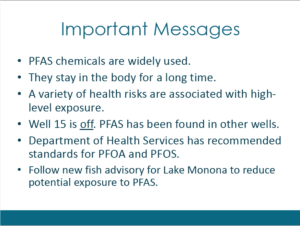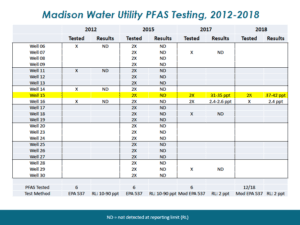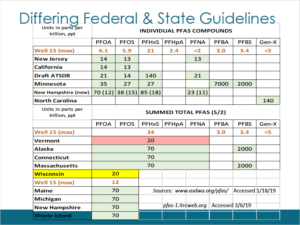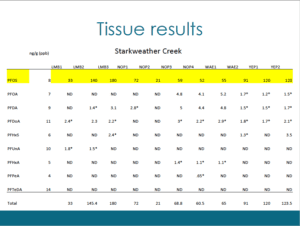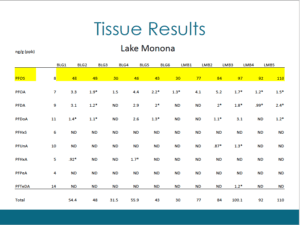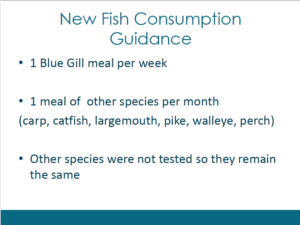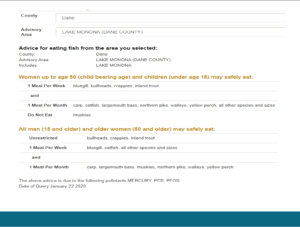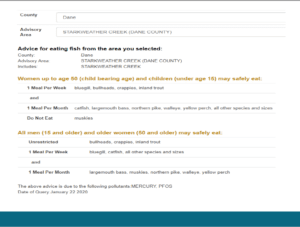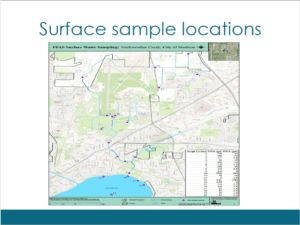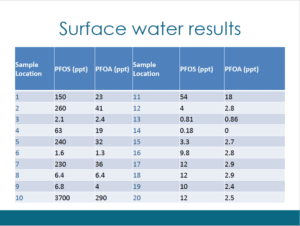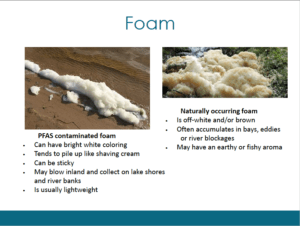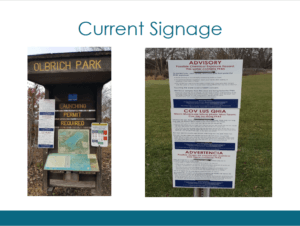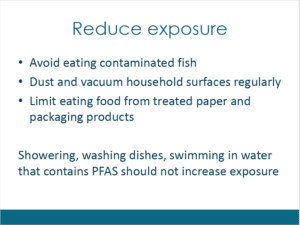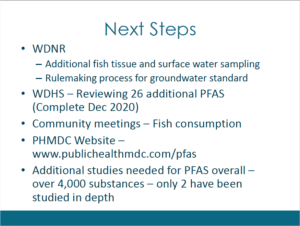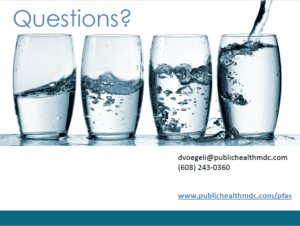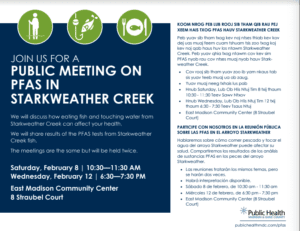Don’t eat fish from Lake Monona or Starkweather Creek more than once a month, bluegills can be eaten once a week. See what else the public health department has to say!Here’s the presentation from the Public Health Department to the Lakes and Watershed Commission from last Thursday. I just have to say, to all my friends and community partners, particularly Maria and Jim Powell, who have been talking about the dangers of eating the fish in the lakes for 10 or more years, thank you for your hard work and dedication to this issue. The very definition of progressive.
Doug Voegeli the Director of Environmental Health with the Madison and Dane County Public Health Department gave this power point presentation. Lakes and Watershed Power Point
Voegeli wants to talk about three different ways that PFAS are impacting Madison and Dane County surface water, groundwater and then also our fish in our lakes. A quick chemical lesson PFAS our poly per and polyfluoroalkyl substances – a structure is right up here.
This little head here changes and it changes the structure of the substances as well as the chain will change as well and it changes the structure of the PFAS. So you hear people talk about a chain six, chain four, chain different size changes. PFAS was produced commercially started in the 40s, really ramped up in the 50s and then on here you can see production was from 1970s to 2002. We are mainly talking about two different compounds here PFOA and PFOS. There are over 3000 chemicals but that actually has been 4,000 and it has been 5,000. So it’s very easy to get more substances, you just change that head, put something on there, make the chain longer or shorter. So there’s thousands and thousands of these compounds and there can be more and more. They’re great compounds for fire resistance, they’re great compounds for waterproofing, they’re oil and water resistant and everything so they were used quite a bit in your core type stuff. The compounds used on a regular basis, the two compounds PFOA and PFOS are no longer produced in the United States, they were voluntarily banned so we don’t see PFOA and PFOS so much anymore, but that doesn’t mean that there’s not still those substances out there. There are and they are just changing the name. A lot of times and you may not think its PFAS but when you start looking at the longer name it is a PFAS substance.
So again they’re used predominantly nonstick coatings waterproof fabrics, your gore-tex, scotchgarding, all has a PFAS in it. Food packaging, that’s what makes it oil and grease resistant when you get that Big Mac that is not leaking on your lap or anything like that. The specialty firefighting foams, the triple F firefighting foams. Again that was primarily used for oil and petroleum fires, it just puts the foam over it completely extinguishes the fire in a matter of seconds. And then coated paper as well.
So as we have all heard if we’ve been reading the newspaper or anything recently these are called forever chemicals, they don’t break down very easily and then some of the longer chain ones may break down but they’re just going to break down into the shorter chain. PFAS substances they’re found in a lot of different sites mainly airports where there is training with a triple F foam around military bases etc and then they also do bioaccumulate. They bioaccumulate in fish.
The primary routes of exposure include eating food that’s packaged in PFAS contained material, in the fish that are caught in waterways with PFAS, drinking water that’s contaminated with PFAS and then any incidental ingestion of dust or soils. With PFAS a lot of that’s more around the industrial areas where there’s a lot of PFAS coming out of companies and settling in that area. Again, and then in a consumer products so it does collect in people. PFAS substances are found in 98-99 percent of us, so most of us in here have a PFAS in our bodies. Most of it is the PFOA and PFOS that’s been measured and fortunately it has been showing a decline in our serum over the past few years of those two substances. But again, remember we’re talking four or five PFAS substances.
There are a lot of health concerns with PFAS. PFAS causes issues in the thyroid, increased cholesterol levels. It reduces the efficacy of vaccines, so we could be vaccinating and PFAS will reduce the efficacy of those vaccines. It’s also been likely to decrease fertility in women, a lot of the studies that have looked at the health concerns of PFAS have been done on animal studies and only really again when we go back and look at the two substances PFAS and PFOS are the most studied and where we have the most information about the health concerns. With PFAS again, we’re talking 3,000 different substances so there’s still a ton of study to be done on all the substances that are still out there now and it will take years and years.
So some things that we just got to keep in mind. They’re widely used, stay in the body for a long time, there’s a variety of health risks that are associated with a high level exposure. We’re going to talk a little bit in here about well 15, but right now, at this point in time, well 15 in a City of Madison is turned off. City of Madison has also done a lot of other testing in their wells and has found it throughout the City of Madison. The Department of Health Services recently sent the DNR the interim standards for PFOA and PFOS of 20 parts per trillion and they are also looking at twenty other substances. DNR is asking DHS to look at it, so DHS starts pulling all the studies that they can together and start reading them and then use their knowledge to help come up with a standard that would work and they’ll send that back to DNR. Then DNR starts the the rulemaking process which I think I read today that they are starting the rulemaking process on the PFOA and PFOS interim guidance that was sent to DNR. Also just recently, actually last Wednesday, a new fish advisory came out for Lake Monona. So hopefully we’ll talk about it a little bit here but the fish advisory does change the amount of fish meals that you can eat safely.
So I just want to touch on some of the monitoring that is happening. I’m just going to talk here about Madison water utility and the testing that was done in in their wells. It’s important here to note that the testing for PFAS started in 2012 but there is nothing found. It did another sample and test results in 2015 on all wells and there was nothing found, ND means no detect. Down here though a reporting limit is 10 to 90 parts per trillion. What we find then in 2017, as the method changed, the reporting limit and the precision of the laboratories got much better so now they can report down the two parts per trillion. Now we found it in two wells in Madison. So then it was checked again in 2018 and again was found in those two wells 15 and 16. So if I recall correctly I think that we have PFAS substances that would have been found in 10 out of 23 of the wells in the City of Madison. And they are the ones that are doing the most testing. We don’t see a lot of testing coming from the other public water systems at this point yet.
This is just to give you some idea of the well 15 area, where people will be drinking predominantly well 15 water. I think it’s in possibly your area of supervision (pointing to Supervisors Michele Ritt and Paul Rusk) but just that area there is the people that are getting most of the water from well 15. And again well 15 is turned off.
This is a very busy chart that’s got a lot of numbers and a lot of different things on it, but this is just to show you that there are a lot of different standards throughout the United States. The EPA guidance, the health advisory level for the EPA is 70 parts per trillion. Well 15 when all of the these 5 PFAS elements is at 34. You can see some of the other levels in different states New Hampshire just came out and these are changing and dropping quickly. Different states as they are going through the rulemaking process and as they’re finding more PFAS. Here’s where Wisconsin came in at 24 PFOAs right now. Well 15 for those two substances it’s 12, so this is just to kind of show you that there’s standards all over the board across the United States in terms of the PDAS and how they’re being regulated,
Fish sampling was done in October of last year. There was an attempt earlier on in the year but the water levels were so high that the the number of fish couldn’t be caught to get a good sample. So they did another sample in October and were able to get enough species but these are all the PFAS that were found in the fish. Right here is the one that is used to base the fish consumption advisory on. It is the one that accumulates the best in the fish and would be found in the highest concentrations in the fish. When we’re talking PFAS we’re talking parts per trillion, these numbers here are in parts per billion, so just to kind of give you an idea these numbers have to be multiplied by 1000 if we want to compare it to parts per trillion parts per trillion. I’ll show you some slides we will talk two parts per trillion, I’ll make sure that you know that the standards that we were looking at before so these are all in parts per trillion so when we start taking these numbers multiplying them by a thousand we’re talking some pretty high high levels of PFAS in the fish. These are the fish consumption guidelines for Starkweather Creek here and Lake Manona.
They tested blue gills and large mouth bass. So again these have to be multiplied by a thousand to get parts per trillion so again some pretty fairly high concentrations in fish. So um based on the fish tissue sampling and the results the DNR changed the fish advisory for Lake Monona only for Lake Monona has Starkweather Creek they called it a special advisory.
So the special advisory, it can get really complex and difficult so to make it simple this is really where we’re looking at. One bluegill meal per week for anybody, doesn’t matter women, men, children, one bluegill meal per week. One meal of any other species per month carp, catfish, bass, northern, walleye and perch. So there’s other species that weren’t tested so it remains the same because they weren’t able to catch those species. So when there’s additional sampling done and other species are caught and analyzed and the results come back they’ll be added to either the one meal per week or the one the for month.
I’m just going to show this this is what it looks like when you go to the actual DNR website, to pull up the advisory for Lake Monona and it gets a little confusing but you can see it’s still saying the same thing. One meal per week for bluegills, these are species that haven’t been tested yet so they’re still allowed that one one meal per week. They divide up anywhere throughout the state, the advisory is broken up between women childbearing age and children under 15 and men and older women so that that’s how it breaks out. It’s not the easiest to understand. I think the easiest to understand is as one meal of blue gill a week and anything else one meal per month. And then this is just the same thing for Starkweather Creek. So that’s the new fish advisory. It’s changing and then will be a talk a little bit later about how we’re how we adjust to that as the Public Health Department.
I also want to just touch base on some surface sampling that was done. These are all sites that were sampled for PFAS and the results are right here. I was trying to put it all on the screen, these are the samples numbers and these are the levels in parts per trillion. So high but not as high as in the fish, which makes sense when you think about bioaccumulation. Someone asks where sample 10 is. Voegeli points out Anderson St. It’s where the firefighting training facility is. These are the results from the surface water. For public health purposes, really you can in swimming and be in the water. We just don’t want people swallowing the water or anything like that or getting it on their animals where the animals are licking it. You just want to make sure that we’re not ingesting the surface water.
I don’t know if you can tell the difference here but you can kind of see the difference between the colors. Here is a naturally occurring foam (right) and a foam that is PFAS (left). Someone from the audience says that is not right. Voegeli says I get my information from DHS. PFAS is a bright white coloring and it’s usually lightweight and will blow pretty pretty easily across the lake or the stream and it can blow inland. This will accumulate more in the bays and the eddies and will smell differently. Audience members says don’t smell the foam.
I just want to point out here these are the current signs. We put these signs up per the DNR’s requests to just get the information out to people so that people are aware. These are the signs at Starkweather Creek and Olbrich Park. This is a fish consumer advisory sign (on the right side of the picture on the left) This is no longer valid because the advisory has changed so these signs will need to come down. These signs will also be replaced (signs on the right) These signs are saying we’re waiting for the fish testing results. We’ll make those adjustments and put new signs up around, we have 34 spots along Starkweather Creek where we have signage, that’s where we do most of our most of the signage, but we will expand our signage and make sure that we’re hitting access points around all of Lake Monona. I will work with the City of Monona to ensure that we’re getting the access points in that area signed properly. We do have to run the signage by DNR to get their approval.
So this is how you can reduce exposure to people. Avoid eating contaminated fish which we know now that the fish in Starkweather Creek and Lake Monona are considered contaminated and the advisory has been adjusted. Make sure that you are dusting and vacuuming your surfaces properly. Limited eating food from treated paper and packaging products is very difficult for us to do that because everything we do is in some sort of a treated paper product. And again showering, washing dishes or swimming in water is not going to increase your exposure. It’s not a very good dermal . . . not a very good route of exposure.
The next steps. DNR is going to be pull in additional fish samples they’re gonna pull from some more from Lake Monona. I think they were going to go into the Brittingham Park area as well as Lake Wingra. As I stated earlier they started the process for rulemaking on those two compounds PFOAS and PFOS. Department Health Services is reviewing 20 additional PFAS at this point in time so so we’ll have 22 out of 3,000 by December of 2020. There’s people suggesting that we look at this as a class, but some of the compounds vary in toxicity so it’d be very difficult to look at it as a class. Community meetings on fish consumption – we’ve got two meetings scheduled. I’ve got some handouts there and we’ll be doing whatever we can to get the information out to everybody on these meetings so that we can talk to people. We’re particularly interested in populations that are subsistence fishing so we’re doing our best to make sure we’re out reaching those populations. We will be sending out postcards to advertise to hopefully get as many people as we can to these meetings. We have a website that we’re trying to hold all of the information here and by all of the information I mean from the airport, from DNR, from DHS, from MMSD (sewerage district, not school district) As any health information that we can so we’re trying to push everybody to this website. I probably goes without saying additional studies are needed for PFAS overall. We have over 4,000 substances and only two really have been studied to any extent. We need to have more studies these compounds.
Supervisor Chuck Erickson cuts Voegeli off at this point so they can hear from the speakers and end the meeting in time for the county board meeting to start. He asks the commissioners to email their questions. Tells the audience to do the same.
Here’s the full meeting if you want to see the public comments, county attorney and commission discussion on a few other items. There will be a separate blog post with the county attorney.
The meetings about the fish advisories are as follows (from Alder Patrick Heck’s Blog)
Last week the Wisconsin DNR updated the fish consumption advisory for Starkweather Creek and Lake Monona. DNR updated the advisory after testing for fish in these areas and learning they had elevated levels of PFOS.
In this updated advisory, people can eat up to one meal of bluegill fish per week. People can eat largemouth bass, northern pike, walleye, and yellow perch from these two bodies of water up to one meal per month. For example, if you caught and ate a yellow perch, do not eat walleye, northern pike, or any other fish for a month.
To learn more about this updated fish consumption advisory, the community is invited to two public meetings at East Madison Community Center at 8 Straubel Court:
-
- February 8 from 10:30–11:30 AM
- February 12 from 6:30–7:30 PM
- Facebook events for February 8 and February 12
Both meetings will be the same and will focus on the new fish consumption advisory and coming in contact with the water/foam. We will have Spanish and Hmong interpreters available, and one of the meetings will be recorded for anyone who misses it.
For the most up-to-date information on PFAS in Dane County, visit publichealthmdc.com/pfas.
And here’s the flyer (interesting focus on Starkweather Creek and not Lake Monona?)

